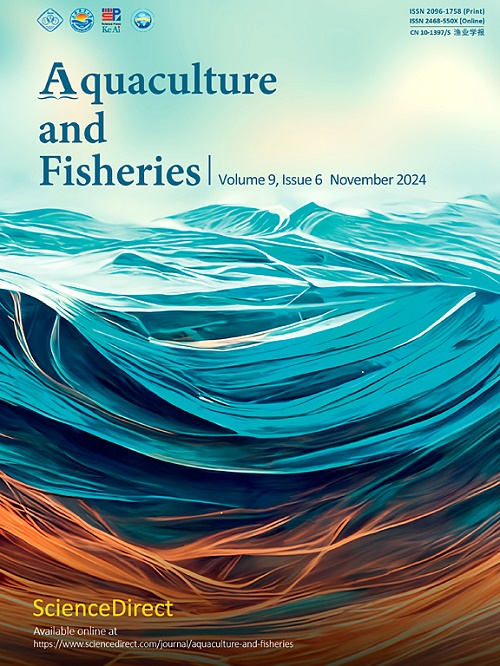低盐度水体Ca:Mg:K比值不同调节频率下凡纳滨对虾苗圃浮游生物群落
Q1 Agricultural and Biological Sciences
引用次数: 0
摘要
本研究的目的是评价在低盐度水体和有共生系统的条件下,不同频率的Ca:Mg:K比值调节对凡纳滨对虾苗区浮游生物群落的影响。用2000只虾进行了40天的苗圃培养。建立了以下处理:1IA(第1天Ca:Mg:K比例调整为1:3:1);2IA (Ca:Mg:K比值在第1天和第20天调整为1:3:1);3IA (Ca:Mg:K比值在第1天、第10天、第20天调整为1:3:1);SW(海水-盐度为31 g L−1);SWD(海水稀释至盐度为2.3 g L−1)。以经益生菌处理的米糠为有机碳源。处理对浮游植物和浮游动物的组成没有显著影响。然而,浮游生物组成在实验过程中存在显著差异。与传统水产养殖系统相比,蓝藻的丰度有所降低。这可以用添加到系统中的益生菌以及受精来解释,这可能限制了这种有害藻类的生长。在整个实验过程中,浮游动物群落以原生动物微生物为主,如变形虫和纤毛虫。在整个实验过程中,还观察到桡足类和轮虫的存在。这证明了合成系统的使用为微生物循环的发展提供了条件,模拟了自然环境。不同水体Ca:Mg:K比值调节频率对低盐度水体和共生系统的凡纳滨照护集约化苗圃浮游生物组成影响不显著。浮游生物组成的时间变化可能是由于有机碳源对系统的施肥造成的。合成系统的使用被证明在微生物环的发育中是有效的,提供了高负荷的微生物的生长,这些微生物可以影响低盐度水中的水质和虾的生长。本文章由计算机程序翻译,如有差异,请以英文原文为准。
Plankton community in Penaeus vannamei nurseries with synbiotic system under different frequencies of adjustment on Ca:Mg:K ratio in low salinity water
The aim of this study was to evaluate plankton communities in Penaeus vannamei nurseries under different frequencies of adjustment on Ca:Mg:K ratio in low salinity water and with synbiotic system. A nursery culture was carried out for 40 days, using 2000 shrimp m⁻³. Following treatments were established: 1IA (Ca:Mg:K ratio adjustment to 1:3:1 on day 1); 2IA (Ca:Mg:K ratio adjustment to 1:3:1 on day 1 and day 20); 3IA (Ca:Mg:K ratio adjustment to 1:3:1 on day 1, day 10, and day 20); SW (seawater - salinity of 31 g L−1); and SWD (seawater diluted to a salinity of 2.3 g L−1). Rice bran processed by probiotic microorganisms was used as an organic carbon source. Treatments did not have a significant effect on phytoplankton and zooplankton composition. However, plankton composition was significantly different over the experimental course. A reduced abundance of Cyanophyta was observed compared to traditional aquaculture systems. This can be explained by the probiotic bacteria addition to the system, along with fertilization, which may have limited the growth of this harmful algae. Throughout the experiment, zooplankton community had a dominance by protozoan microorganisms, such as amoebae and ciliates. The presence of copepods and rotifers was also observed throughout the experimental course. This proves that the use of the synbiotic system provides conditions for the microbial loop development, mimicking a natural environment. Different adjustment frequencies in the water Ca:Mg:K ratio do not significantly change plankton composition in P. vannamei intensive nurseries using low salinity water and synbiotic system. Temporal variation in plankton composition probably occurred due to fertilization of the system with an organic carbon source. The use of the synbiotic system proved to be efficient in microbial loop development, providing the growth of a high load of microorganisms that can influence water quality and shrimp growth in low salinity water.
求助全文
通过发布文献求助,成功后即可免费获取论文全文。
去求助
来源期刊

Aquaculture and Fisheries
Agricultural and Biological Sciences-Aquatic Science
CiteScore
7.50
自引率
0.00%
发文量
54
审稿时长
48 days
期刊介绍:
 求助内容:
求助内容: 应助结果提醒方式:
应助结果提醒方式:


